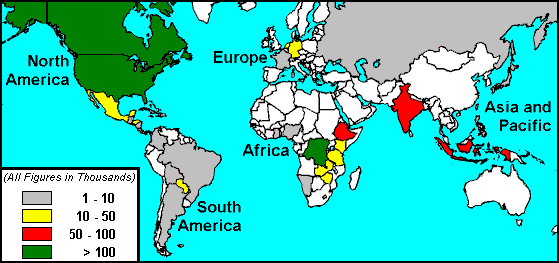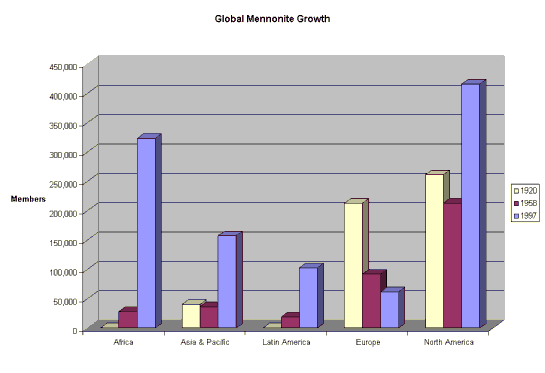Did you know...
Many people think that all Mennonites are of European background. Although this was true at one time, it certainly is no longer the case. The church's historical roots are in Europe, but it has now spread virtually around the world. There are Mennonites in Africa worshipping in their native Swahili, others in Central and South America speaking Spanish, Portuguese, and German, still others in Asia speaking Cantonese, Vietnamese, and Hindi, and the list goes on and on.
World Mennonite Church Membership

Source of Information: Mennonite and Brethren in Christ World Directory: 1998 (Kitchener, ON: Mennonite World Conference), 1998.
Click on a continent for more information about the Mennonite church in that area.
Some Basic Facts
For the first time in history, it is estimated that there are more than 1,000,000 baptized members of Mennonite and Brethren in Christ churches world-wide! Probably even more surprising (especially to Mennonites in North America), there are actually more Mennonites in the South (Africa, Asia, Central/South America) than in the North (Europe, North America). There are almost as many baptized members in Africa as in North America, and more in both Latin America and Asia than in Europe.
Sources of Information: Epp, Frank H., Mennonites in Canada, 1920-1940: A People's Struggle for Survival (Toronto, ON: MacMillan of Canada), 1982, p.2; Bender, Harold S., "World Mennonite Membership Distribution," ME IV, 980-981; Mennonite and Brethren in Christ World Directory: 1998 (Kitchener, ON: Mennonite World Conference), 1998.
Mennonite Membership (# of Countries)
| Region |
in 1920 |
in 1958 | in 1997 |
| Africa | 200 (1) | 27,809 (4) | 322,708 (12) |
| Asia & Pacific | 40,000 (4) | 36,013 (5) | 157,075 (9) |
| Latin America | 100 (1) | 18,479 (11) | 102,496 (24) |
| Europe | 202,500 (7) | 91,764 (9) | 61,886 (13) |
| North America | 261,300 (2) | 212,439 (2) | 415,978 (2) |
| Total | 514,100 (15) | 390,497 (31) | 1,060,143 (60) |
Sources of Information: Epp, Frank H., Mennonites in Canada, 1920-1940: A People's Struggle for Survival (Toronto, ON: MacMillan of Canada), 1982, p.2; Bender, Harold S., "World Mennonite Membership Distribution," ME IV, 980-981; Mennonite and Brethren in Christ World Directory: 1998 (Kitchener, ON: Mennonite World Conference), 1998.
Quiz
1. What are the 5 countries with the highest Mennonite church membership? (Hint: remember, Anabaptists began in Europe!)
2. Compare the map on this page with that on the World Church "Migrations" page. In terms of migration and membership, what do Asia and Africa have in common?
3. About how many languages are spoken by Mennonites in the world church?
1. Top Ten Countries in terms of Mennonite Membership (1997):
- United States (287,345)
- Republic of Congo (175,837)
- Canada (128,633)
- India (87,466)
- Indonesia (62,823)
- Ethiopia (57,011)
- Germany (39,610)
- Tanzania (32,100)
- Paraguay (25,009)
- Mexico (20,689) / Zimbabwe (20,606)
2. There could be several answers. For one thing, neither continent has had significant "ethnic Mennonite" migration. Nonetheless, these regions have the largest Mennonite churches in the world, outside of North America.
In fact, the African continent has the fastest growing Mennonite church in the world! There have even been several instances in Africa where churches have declared themselves to be Mennonite after reading and agreeing with Mennonite literature without having contact with the historical Mennonite church - a true case of spontaneous Mennonite expansion!
3. Mennonites in the world today speak more than 75 languages.
The Mennonite church has grown to include people of over 100 cultures on 5 continents.
So what?
These statistics are living proof that being Mennonite is much more than being part of an ethnic group. The beliefs and practices of this church have been accepted by people of many cultures, who have adapted them to address local issues and be sensitive to local cultures.
This changing reality brings both new opportunities and challenges. The Mennonite World Conference is one organization which seeks to harness this vast diversity. It organizes international conferences about every 6 years; the most recent one was hosted by the church in India in 1997.
Created 1998 by Derek Suderman
